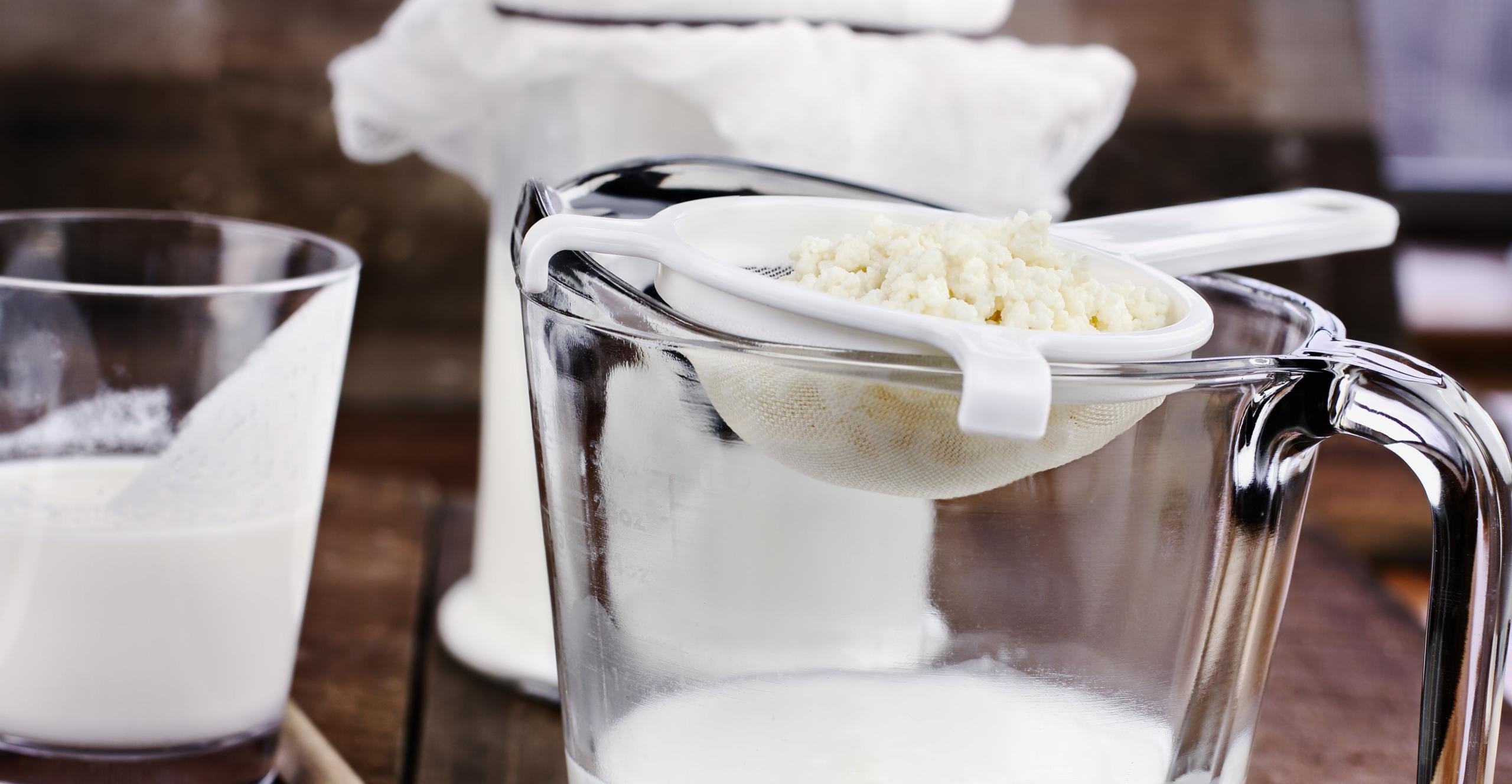Milk Kefir FAQ | Straining
Table of Contents
- How do I Separate the Grains From the Milk Kefir?
- Why Does Straining Milk Kefir Take so Long?
- How Can I Strain Milk Kefir Faster?
- What Should I Do If My Kefir Is Overfermented and Very Separated?
- Why are There White Clumps in the Strainer?
- Why Have My Kefir Grains Disappeared?
- What Type of Strainer Should I Use for Milk Kefir?
- Can I Use an Electric Whisk to Speed Up Straining?
- How Do I Clean My Strainer After Straining Kefir?
- Can I Use a Metal Strainer for Kefir?
- Why Is My Kefir Too Thick to Strain?
- My Kefir Grains are Getting Pushed Through the Strainer. What Should I Do?
- Should I Wash or Rinse My Kefir Grains?
- Should I Stir or Shake Kefir Before Straining?
- How Do I Prevent Losing Grains While Straining?
- Can I Use Cheesecloth or a Coffee Filter Instead of a Strainer?
How do I Separate the Grains From the Milk Kefir?
This involves straining milk kefir through a sieve by first stirring or shaking the jar, and then pouring the contents into a strainer. Then, using a spoon or spatula, you stir or swirl the mixture, pushing the liquid and milk curds (white lumps) through the strainer, until only the milk kefir grains remain.
Why Does Straining Milk Kefir Take so Long?
Straining milk kefir generally takes a minute or two – this is normal. But the equipment and technique that you use can make a difference that adds up. We talk about this in the section below. Not stirring or shaking your milk kefir before pouring it into the strainer can also increase straining time.
How Can I Strain Milk Kefir Faster?
Straining milk kefir with speed means using a correctly sized mesh, the correct utensil, and a good technique.
Equipment
Strainer
To increase the speed of your straining, using a sieve with the correct hole size is important. A sieve with holes too big risks the loss of the kefir grains, whereas a sieve with small holes adds unnecessary time to the straining process.

Above is an image of 2 sieves and a colander. The colander has holes that are 2 x 2 mm in size, making it unacceptable for straining kefir, as small kefir grains are also about 2 mm in size. The small sieve with holes 1 x 1 mm in diameter does the job, but it does take longer than the middle sieve, which can strain milk kefir faster without risking the loss of small kefir grains.
Choice of Utensil
Metal Spoon (Slowest): Pushes fewer kefir grains and milk curd with every stroke, increasing straining time.
Silicone Baking Spatula (Moderate Speed): Has a greater surface area, increasing speed at which you can fold, press, and scrape the thickened milk kefir. Use a spatula with little flex.
Slotted Nylon Spoon (Fastest): Fastest option, can significantly increase your straining speed with the correct technique (expanded upon below).
Technique
As you get the hang of your technique, you can strain the milk kefir grains much faster. Below are two different techniques, depending on your choice of utensil.
Using a Spoon or Silicone Baking Spatula (Slower)
- Stir or shake the milk kefir until it is even in consistency
- Pour the milk kefir into the strainer
- Using a metal spoon or spatula, stir or swirl the liquid until it becomes thicker in consistency
- Using broad strokes, push the grain and curd mix from side to side until almost only the kefir grains remain
- Press and fold the grain and curd mix until only the grains remain
Using a Slotted Nylon Spoon (Fastest)
- Stir or shake the milk kefir until it is even in consistency
- Pour the milk kefir into the strainer
- Keeping the back of the nylon spoon facing the bottom of the strainer, move it in a circular motion until almost only the kefir grains remain
- Scrape the grains and curd mix into a single mass
- Pressing the back of the spoon on the mix, gently move it in a circular motion until only the grains remain
What Should I Do If My Kefir Is Overfermented and Very Separated?
Strain the milk kefir as normal; it will just be slightly more difficult. To make the process easier, sir or shake the jar until the kefir is consistent in texture, before pouring it into the strainer.
Why are There White Clumps in the Strainer?
The white clumps are called milk kefir curd. It is mostly made up of casein protein and fat from the milk, which separates at a low pH. This is not generally something to worry about, but if your milk kefir is fully separating into a layer of whey (yellow liquid) and milk curds, your kefir is overfermenting, which can result in a gritty texture and sour taste.
Why Have My Kefir Grains Disappeared?
Ninety-nine per cent of the time, your kefir grains haven't disappeared and are hiding in milk curds. To find your kefir grains again, simply keep straining until only the grains remain in the strainer. However, we have had cases of customers using sieves or colanders with holes much too large, losing the kefir grains in the straining process.
Make sure this doesn't happen to you by using a sieve with small holes. In rare cases, kefir grains can become damaged by an excessive transit time or by excess heat – this damages the grains, causing them to first become mushy, and then to fall apart and dissolve over time.
What Type of Strainer Should I Use for Milk Kefir?
The best type of strainer is a mesh strainer with small holes that do not allow the kefir grains to pass through with the milk curd and liquid. A fine mesh or nylon strainer works wonders for this.
Can I Use an Electric Whisk to Speed Up Straining?
No, an electric whisk is too rough. It has the potential to rip apart and damage your kefir grains.
How Do I Clean My Strainer After Straining Kefir?
Turn your strainer upside down and rinse it under running water to clear the vast majority of milk curds or small stuck kefir grains from the holes of the strainer. You can then place it in your dishwasher or scrub it with hot water and soap. Ensure that no residual detergent or soap is left on your strainer, as this could harm the grains.
Can I Use a Metal Strainer for Kefir?
Yes, you can! Using a stainless steel strainer will not harm or kill your kefir grains. This myth began when sieves were made of tinned steel or brass rather than stainless steel.
These two metals are more 'reactive' than stainless steel and would corrode and leach metal ions upon contact with the acidic milk kefir during straining. These metal ions are toxic to the microbes found within the grains, damaging and killing them over time.
Why Is My Kefir Too Thick to Strain?
Thick milk kefir is common, especially if your kefir is highly fermented or has been fermented at cooler temperatures. You can make straining easier by using the correct equipment and straining technique. Stirring or shaking your milk kefir before pouring it into the strainer loosens curds and reduces straining time.
My Kefir Grains are Getting Pushed Through the Strainer. What Should I Do?
If your grains are slipping through the strainer, it means that the holes are too large. Swapping to a finer mesh nylon or stainless steel strainer will prevent this from occurring. If extremely small grains are passing through, you can simply leave these in the milk kefir – they are safe and healthy to consume.
Should I Wash or Rinse My Kefir Grains?
No, you shouldn't rinse your kefir grains with milk or water after straining, despite what you may have heard. This removes the protective biofilm from the outside of the kefir grains, increasing the risk of contamination by foreign microbes or mould, and slowing down grain growth. This biofilm also acts as a reservoir for the microbes, helping to kick-start the next fermentation. In fact, some species of bacteria and yeast are only abundant in these biofilms, not in the grains themselves.
Should I Stir or Shake Kefir Before Straining?
Yes, stirring or shaking the jar before straining helps to break up milk curds, which makes straining much easier.
How Do I Prevent Losing Grains While Straining?
Use a Strainer With a Fine Mesh: The mesh should be small enough to catch the kefir grains without causing the liquid to take forever to pass through.
Stir Gently: It is hard to push kefir grains through the mesh, but it is possible.
Scrape All Grains From the Strainer: Scrape the mesh of the strainer to collect any small clinging grains.
It is normal to lose a few tiny grains during the straining process, but don't worry – growth should outstrip any small losses.
Can I Use Cheesecloth or a Coffee Filter Instead of a Strainer?
No, we wouldn't recommend using a cheesecloth or a coffee filter in place of a sieve for the reasons below.
Cheesecloth
- Needs to be coarse to push the milk curds through.
- Difficult to clean.
Coffee Filter
- It will only filter whey out while leaving the milk kefir grains and milk curds behind.
- It is liable to tear if you use a spoon to agitate the mixture during straining.


